Introduction
As Disney Create has closed and many of this wiki's members are looking for other things to do, I have noticed that many of you have shown an interest in writing, storytelling, and the like. I'm honestly not surprised, since it's quite common for an artist to take a liking to these things. This is often because we like the idea of being able to show our creativity to a different extent than just our drawings could take us. At least, this is how I see it. I've always personally loved both of these hobbies, and am always trying to use both of them interchangably to express myself as much as I possibly can. Of course, this usually ends up in some sort of humourous result, and I know that this is not necessarily what everyone always wants to express. I also know that not all of you may have had the most experience in writing (like myself), and are probably just beginning to really test the waters, not exactly sure what you should expect. I find it unlikely that most people here have had the opportunity to join a creative writing class, and have mainly been doing essays throughout school. We're all in the same boat. However, being the person I am, I not only like to read books, but I also enjoy thinking about the structure of the story, the author's skill, and the quality of the characters. Just like with drawing, I believe that we should all have something to refer back to whenever we feel that something in our story just doesn't seem to "click." Rather than rereading a bunch of other books to improve your own, I've decided to try and simplify some tactics used by authors to my best ability, and I hope that any information I add will prove itself to be helpful! I will be splitting off sections relating to comics and normal writing too, since I feel that both are very different but need to be covered all the same.
Characters
A story's characters are probably one of the most important elements in a piece of literature, if not the most important. You can have an amazing story idea, but if your characters do not appeal to your audience, there will probably not even really be an audience for it. So, how do you create a character that your readers will appreciate? Before you can even begin to create your characters, you need to have a basic story idea. This can be anywhere from just a few words to some basic plot details about the story. I find that it works best whenever I completely figure out a character's appearance, personality and all of that before I begin writing rather than as I move along in the story. This way I can base the sequence of events off of how the character reacted in certain situations, and not just have his or her actions slip by.
People appreciate realistic characters that they can relate back to themselves or someone they know. This is true for everyone. Stereotypically evil or good characters can get you by for some of the roles, but they will be much less interesting to the readers than a character whose personality seems to be a fair balance of the two. This balance of good and bad characteristics is very important in all character roles, even if they're supposed to be exaggerated. I've made a list of positive qualities balanced with negatives that I commonly see in real people. I hope they help! Note that all people with one positive trait will not necessarily have the negative trait as well. Stupid people can be know-it-alls, and smart people can be very accepting. These are just examples.
Extremely smart- Know it all
Hardworking- Often overworks self
Kind- Very sensitive
Popular- Doesn't come from desireable family situation
Pretty- Self degrading
Funny- Insensitive
Mature- Uptight
Calm- Lazy
Like I said before, these traits do not alwaus have to appear together. A kind person can be self degrading, and a pretty person can be uptight. Though I did use pretty and popular on this list, they shouldn't be any given character's only good trait. We've all seen the cheesy highschool movies. The popular people are beautiful, but they have no clear reason to be popular. These stereotypical popular girls are often added to the plot lines as the "bad guys" way too often (in my opinion), and the "good guys" are the girls who are apparently "completely innocent," kind, have no reason for the other girls to pick on them, and are just as pretty. Perhaps if they had done something major a year or two back that really caused a reason for the popular crowd to loath them as much as they do, then it would be acceptable. However, without this information the story becomes very bland, stale, and one-sided. If the plot were to be written from the other side of the story, the well-liked group of girls would likely have reasons for most of their actions.
It's perfectly okay to make villains act like stereotypical villains when they're some sort of supreme being who hates the human race, but if they're just supposed to be like your average person who loaths your protagonist, some more thought will need to be placed into their character development. Where did they come from? What have they experienced? Do they have any mental issues? How has that affected who they are? If a child's father was abusive to them, then they might grow up loathing him and will bring some of his qualities along with them. It's also common for villains to be psychopaths, which does not necessarily mean that they are insane. Psychopaths, by nature, are unable to love or feel emotion towards others, which would mean that the deaths of others would not affect them. However, as with anyone else they would have likely had something happen to push them on the path that they're going. Either way, both of these types of villains are more common in the action oriented genres along with sci-fi and fantasy rather than in realistic fiction and humor. In those two genres, the antagonists are often average people who simply dislike the main character(s). Of course, that's not to say that these types of antagonists never appear in the more realistic genres. It's just less common.
Mary Sues
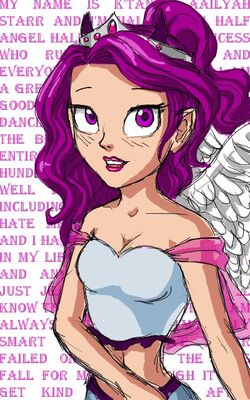
A Mary Sue character
'
However, the overly villainous villains are normally not problematic to a storyline. There are plenty of books such as Harry Potter and Lord of the Rings which contain these types of antagonists, and they are still very interesting and successful. Nevertheless, there is still another character type to look out for, and these are the perfect protagonists, which are more often refered to as "Mary Sues/Gary Stus." Mary Sues are the characters who seem to be perfect in every way. If they do have any flaws, they're very minor and will (in some cases) end up enhancing the character's perfection. Usually, the Sues will have some sort of extremely terrible backstory as their only flaw. These can be suitable when used in the correct manner, but often their backstory is blown entirely out of proportion and is really only used for the purpose of an appeal to pity. It's perfectly okay to have an awful backstory for your character, but you must realize that the more elements you add to it, the harder it will be to keep your character from becoming a Sue. If your character has truly suffered through something, then make them act like someone who has done so. This doesn't mean always whining and crying about their past at every turn, and their friends don't have to always be there for them or talk about how bad they feel for your character even when he or she is not around. The other characters should also be able to spend some time in the spotlight and think about their own problems, even if your story is entirely in first person. It's rare that anyone is ever always doting on someone without profit in real life, so there's no reason why it should be this way in your story.
Even if you're going for fantasy or Sci-Fi, it's key to make sure that certain things are still in proportion, including personality and ability. A person is a person, and we all have flaws, as I have stated earlier. I may end up repeating myself multiple times, but making sure that your characters are geared up with both good and bad traits is very very important. And it must be remembered that both good and bad traits can still come in different degrees. It's extremely rare that your character will be the most beautiful woman in her entire country, but will be so stupid that she forgets where the bathroom in her house is. It would be much more reasonable for the girl to just be pretty and possibly have some learning disabbility, such as dyslexia. And no, I do not mean that by making this character have dyslexia that their brains were "actually wired to learn a different language." I actually mean that the character has dyslexia. That whole thing has already been used in the "Percy Jackson and the Olympians" series, and if you were to use that for your own characters, people would notice it and call you out on it. So, if you want to draw ideas from other forms of literature, you should at least make them discrete and change them enough so that they're original. However, if you're writing a fanfiction the rules are usually a bit different, though I'm not very experienced in this field and am generalizing this article to mainly original stories. However, if you are deciding to write a fanfiction, then please note that when adding original characters you MUST tread the waters of Mary-Suedom much more carefully than if you're deciding to create an original story. You'll have to make sure to stick with the original story line for whatever your fanfiction is based off of, and should not deviate away from that along with the established characters' personalities, even if it's convenient in your story. If you're changing the characters enough, you might as well just create an original story anyway and change up some names.
Anyway, now that the whole fanfiction thing has been cleared up, there are a few more things to address. We've all read the stories where the main character is "secretly of royal decendent" or "randomly receives super powers at the right time." It can even be that everything just comes naturally to the character, whether it be sword fighting or drawing. Though magical powers and princesses are cool and everything, having your characters suddenly receive these authorities can be depriving you of some very interesting story material. Rather than writing a story where your protagonist suddenly is placed into royalty and the rest of the story is dragged out, you can write a story about a humble farmer who is faced with challenges that cause her to want to work her way up into the army. The journey is always more interesting than the destination when you're creating a story, and this should be kept in mind. Nothing should be rushed, and your story should be kept at a realistic pace, as should your character's development in skills and personality.
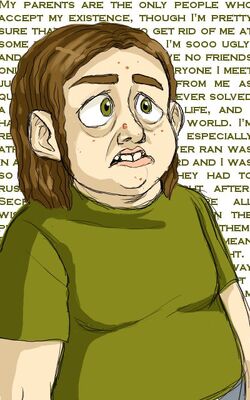
An Anti-Sue
Of course, Mary Sues do not always have to be perfect at everything or there just for you to pity them. There are still two other Sue types that are created for the sole purpose of not being a Mary Sue, which are the Jerk Sue and the Anti-Sue. The Jerk Sue is still a Mary Sue in most ways, but, as the title implies, is a complete and total jerk. These are usually female characters who are taken to the feminist extreme, and the character ends up being very mean and a total bully while still being shown as an ideal person. They hate people in general, and basically just want everyone to get out of their way because they're the most qualified here, which is often true. Basically, this is really a character whose positive and negative traits have both been blown out of proportion, creating a character that the readers hate and the other characters fear. The Anti-Sue, on the other hand, is exactly what it sounds like. The author will usually think that making their character completely opposite of a Mary Sue is a good thing, while in reality it is not. Their character will be so hopelessly ugly, pathetic, mean, disgusting, etc. with no friends and no one who likes them at all. They can't do anything, and so this apparently makes them a good character. However, they are still considered a Sue because of everyone else's over-the-top reactions to them and all of the exaggeration on their flaws. If anything, people hate these characters more than they hate the regular Mary Sues. I, personally, would prefer to read about someone who can solve their own problems than someone who is constantly failing and falling into stages of anger and depression. At least Mary Sues can accomplish things. However, as I have said multiple times already it is good to find a balance of the two. Everyone has Mary Sue qualities, but not so many of them that they become supernatural. You can still have a beautiful character who is not a Mary Sue, or a character who is not stageringly gorgeous who is also not an Anti-Sue. If you make sue to keep them in balance with other qualities, they will most likely be okay.
===Character appearance' ===
Alright. So, you have your characters' personalities, abilities, social standings, and other things of that sort worked out. It's also quite possible that you have created general appearances for them by either drawing or by a vague description. Of course, you'll need to be able to convey how they look to your audience, and this is clearly going to be very different in comics compared to a regular novel. I've decided to split the two up into separate sections, since you will not need both descriptions for both types of stories.
Regular stories[]
As an author, it's your job to describe a scenario as best you can through words, and it will be the same with your characters as well. However, if you go into too much depth while describing each of your characters, the readers will probably tire of your story. If your character has a wild appearance that you absolutely need to explain in detail so that your story will make sense, a comic book will probably be a better choice, or at least a book with illustrations to go along with it. You must understand that when people read a novel, they don't want to read a whole bunch of details. Most of the appearances of things such as buildings and characters will be left up to their imagination, and they will just fill in the gaps how they see fit. If you take up your time overdescribing things, the focus will be taken away from the actual plot and the story you were going for will be ruined.
So, how will you describe your characters' appearances, exactly? If your story is being told in 3rd person, then this will be much easier. You can simply describe how a character looks without having to also add in the thoughts of your main character. However, you must keep in mind that you cannot go overboard with details or not give nearly enough to paint a clear picture.
Too little: A tall man with dark hair walked towards Robert, and made him feel uneasy.
Too much: A tall man walked towards Robert, with medium brown skin and dark brown hair that covered only the top half of his forehead. It was swept over to the left side of his face, which had a very distinct jaw line and somewhat bushy eyebrows. His eyes were a deep shade of blue, and his nose was proportioned fairly well to the rest of his face. His build was not too lean, but not too muscular either, and he wore a black biker's jacket and a red t-shirt underneath that. He also wore light blue jeans that were worn around the knees and had grass stains on them, along with black boots that reached mid-shin. A sort of smirk was etched on his face, and Robert was a bit unsettled by it.
A good amount: A tall, lean man walked towards Robert. His dark hair was brushed over to one side of his face, which was grinning mischieviously. His eyes were dark blue, and he wore a black leather jacket with worn out blue jeans. Though he was fairly good looking, he didn't necessarily give off the kindest of vibes, and Robert began to feel uneasy.
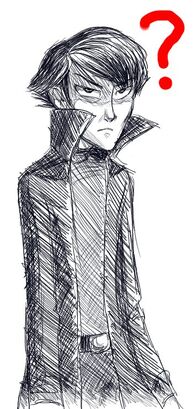
Without enough information, the reader doesn't get a very accurate portrayal of the character, and that may make that particular character seem unimportant, or their appearance may be very different from how you had originally intended it to be. For instance, this particular character could end up seeming more ominous and formidable than his is meant to seem. All me know about him is that he's tall, has dark hair, and is making the character Robert feel unsettled. Most people would draw the conclusion that he is evil in appearance, and would probably come up with the character on the left or something close to that. This conclusion is, of course, very different than what the author would have been aiming for and the reader may be confused later when they find out that the character is actually pretty tough and jovial compared instead of mysterious and dire than they had originally assumed at first glance.
And as I have already explained, concentrating on the appearance of the character more than is needed will just deprive the plot line of the tension that was building, and will instead turn the focus to how the character looks rather than how he is behaving. What could have been a crucial moment for Robert has lost a portion of the potential which it had before, since the reader's attention has turned from the actual story line to how the newly introduced character appears. Detail is good, but, just like everything else, should be used in moderation.
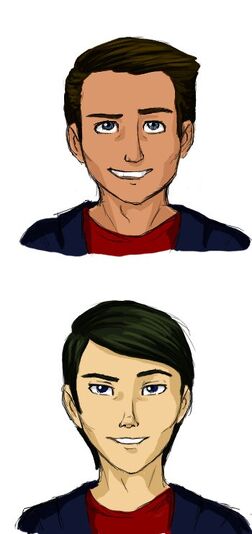
Now, I know that I still have a lot to work on when it comes to writing, but as for now I am trying to give an example of what I see fit. In the sentences I have used as an example, there is enough information so that you can tell what this character's basic appearance looks like, and you also have a brief glimpse at his personality and how he rubs off on other people. So, what will the readers likely gather from this description? They know what he looks like, and that his clothing is probably not in the best condition, which implies that he does a lot of activities which would cause them to wear out. The fact that he makes Robert uneasy suggests that he's troublesome as well, and his character could be one of the "bad boy" types. In fact, since he's smiling while approaching Robert, we can also assume that he might be preparing to stir up some commotion at that very moment. The reader is not quite sure why he's walking towards Robert, or what his intentions are, but they have a pretty good idea. Knowing these general facts will be enough to allow them to make a judgment on the character, and they will be able to fill in the rest of his appearance through what information has been given. As shown on the right, the two characters look very different, but still have the same demeanor and overall basic description. If you're planning on writing traditionally, you should be okay with your characters being left up to the reader's interpretation.
If you've decided on writing your story in first person, however, you should first realize that it will be much more difficult to describe your characters than it would be if you were writing in third person. This is because you will be looking from the eyes of your character and will be narrating their thoughts rather than simply stating the facts. First person is very rewarding when you need to give your main character's opinions on something, but can be a bit confusing when you want to get across how another character is feeling or how they look, since if you go into too much depth it will just seem like your protagonist is a creep. It's becoming more common to switch points of view with each chapter and such, but I do not recommend doing this, since it can seem a bit confusing or ridiculous. My father talked with his students about these kinds of books once, and they said that it just made the books seem sort of overstuffed and it didn't flow too well, either. So, if you need to show the thoughts of any more than two characters, then it would probably be best for you to just stick with third person omniscient instead of jumping around to different characters. If you do decide to stick with telling the story from your main character's point of view, however, then there are some things that you must consider when describing other characters.
- Keep your main character's personality and opinions in mind! Some characters may be creepy stalkers, but others may be insensitive and will not give much thought to how another person will look. Do not have your character suddenly turn to a different person when they talk about other people
- Yes, your character is allowed to make ridiculous side comments. If that's what they'd be thinking, then that's what should be written. Simply enough.
- As I said before, do your best job not to describe another character too much. One extra detail could make it sound like Robert has a man crush, and that may not have been what you were going for.
So, to get a good idea of where we're going with describing this character, we'll need to have a good idea on how our main character would think in this situation. Going from the POV of Robert, we can say that Robert is not necessarily the best at athletics or defense, and that he likes to make witty remarks and is not the most sensitive person in the world. That's about all we need for this particular scene. Naturally, we will have to reword the part about the other man being attractive, since Robert is likely not the type of person to comment on such things.
First person: A tall man with dark hair brushed off to the side of his face walked towards me. I wasn't sure what he wanted or who the heck he was, but all I knew was that I needed to get somewhere and he was blocking my path. He cracked a smile, though it wasn't exactly like the kind of smile you get from the teacher when you answer a difficult question correctly in class. It was more of a "Hey, kid. You're going to make a great punching bag for me and my buddies" or something like that kind of smile. I didn't know, since I'd only really seen that kind of smile in movies or that one time in fourth grade where I did end up becoming the punching bag. I may have deserved it, but that's besides the point. This guy seemed tough enough that he could actually do real damage to me, and he looked like one of those bad boys that girls are into these days for some strange reason, which didn't exactly comfort me either. By now, it was clear that he was concentrated on me. I began to get anxious.
As you can see, I added quite a bit more information into this particular description, though a majority of it was based on Robert's comparissons and thoughts on his current situation. It should be noted that when describing a character in first person that you're not necessarily describing the character's actual appearance, but rather how he appears to your main character.
Comics and mangas[]
The set of problems you'll be facing if you decide to tell your story in the form of pictures rather than words alone is very different than when you're simply writing. You do not need to worry about describing the characters since they'll be right in front of the reader, but will rather need to worry about making your characters distinct from one another and being able to draw them consistantly from panel to panel. This will, of course, present a very difficult challenge. You will need to memorize how their features are placed compared to your other characters, and will also need to carry those proportions out throughout your story. However, this is not something that you can't fix. Just like with anything, you will need to be patient until you improve.
Now, I am definitely not an expert on drawing comics and am probably in the same boat as a majority of you who are reading this, and all I can say is that any of you who have tried drawing even a comic strip know that it's hard. And I'm not just talking about the quick ones that you doodle for fun. I mean the ones where you're actually trying to get your character to look exactly the same at any different angle from which they're being viewed. This takes a lot of practice and skill, and I myself am not experienced enough to be able to teach you anything about it. However, there are other artists who have already answered the question of drawing a character consistently. If you would like to learn some more on this topic to help you improve, feel free to check out these links:
http://paperwingspodcast.com/the-secret-to-drawin-expressive-consistent-characters/
https://sites.google.com/site/houseotwisted/junk/20drawings
http://www.finearts360.com/index.php/drawing-your-comic-characters-with-consistency-5390/
If there are other areas that you struggle in that are not mentioned in any of these links, there is likely either a tutorial on that subject or a list of tips as seen in these links. What I'm going to mainly focus on for this section is differentiating your characters, which can also be helpful if you just decide to draw them as illustrations in your novel. This doesn't necessarily mean that you can only do this for comics. In fact, if you just look at the Harry Potter books (I'm using the American versions as an example) you can see that each character on the cover as well as in the book itself look very different, though they still maintain a consistent art style.
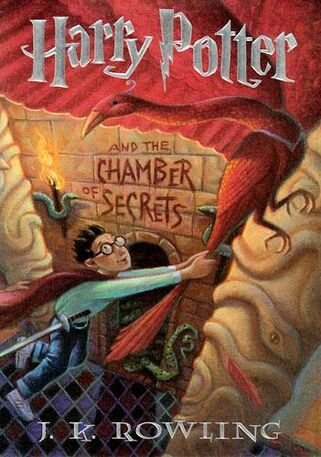
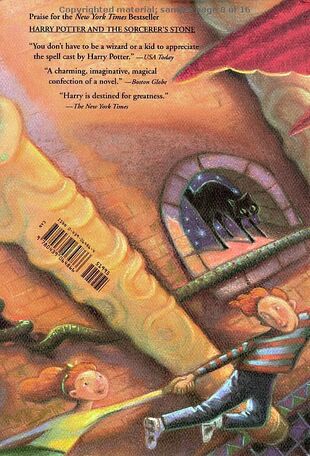
You may need to click on the images to get a better view, but you can see that Harry, Ron, and Ginny all have distinct facial proportions when compared to one another. Hary's face is more angular than either Ron or Ginny, whose faces are both a bit rounder. Ron's face is also elongated to make more room for his nose, which had been described as long in the books as well. Ginny's head is mainly a circle with modifications, and she actually sort of looks like princess Merida in this particular picture (at least, that's how I see it).
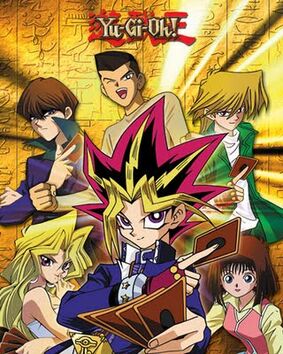
Of course, every artist will find a different method if distinguishing each of their characters from one another. In most mangas and animes, the hair is usually the main factor of identifying characters. In many mangas, the characters will wear school uniforms and their faces will be very similar, so most artists rely on the hair to let the readers tell the characters apart. There will, of course, often be facial modifications between characters as well, but they're discreet enough that a fair amount of readers or viewers would not be able to tell that particular character from another one within the first few chapters or episodes. Though Yu-Gi-Oh is a very extreme example (since a majority of the characters have wild hairstyles), it's definitely a prime example of this method of differentiation being used.
You could easily pick out the main character even if he wasn't centered on the page. Since his appearance is the most distinguished out of all the other characters, most people would guess that he plays a very important role in the story. This is also a method that you'll commonly see in the media, whether it be that the hair, facial features, clothing, or something else sets the main character apart from the rest and causes your attention to focus on him/her instead of the others. This is, of course, not used in every story, and we have all seen plenty of comic books where the protagonist is not the character who has the crazy appearance. However, it's an easy way to place attention on your main character.
In Japanese mangas, everyone knows that the eyes are also very important. In fact, they're what often defines the style as appearing to be Japanese in the first place. Most of the focus in emotion and character is placed on them, too. In the Yu-Gi-Oh picture, you can make a guess on what this character will be like just by looking at their eyes. Would you believe it if I told you that the two leftmost characters were portrayed more as villains, and that the girl in the bottom right corner is often seen as being friendly? This assumption would not be difficult to make, and so the author would likely use this to his advantage. You could, of course, switch the personalities around, but if you want a particular character to make an evil impression or a good impression at first glance, their face should naturally fit the bill.
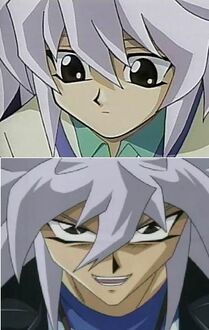
Yu-Gi-Oh also uses this a lot to differentiate the dark version of a character from their good side. In the story, there are quite a few characters who are posessed by evil spirits, basically, and so when the spirit is the one who's acting, it appears that way too. This can be seen in the character on the left. Clearly, he is an entirely different person in a sense. You can tell immediately that he has gone from good to evil just by looking at him, and this kind of change in appearance is necessary if the change in personality is rapid. Otherwise, if he began acting in a dark manner out of the blue it would be very confusing. This technique is, of course, not needed if the change occurs over a slow period of time and you can clearly tell that the character is developing gradually into a different person than they were before. This, my friends, is what we simply call "character development."
Okay, so let's assume that you are creating a group of characters whose appearances need to have most things in common. They may be required to wear the same uniform, have the same haircut, and in some cases are all of the same race (meaning that their hair color and skin would be very similar). How would you be able to tell them apart in this situation? Well, rather than relying on alterable things such as hair, clothing, and accessories, you'll probably want to change some aspects about the characters themselves. Unlike in Japanese mangas, you will probably not have the luxuries of giving your characters subtle differences to identify them, such as changing the eyes a bit.
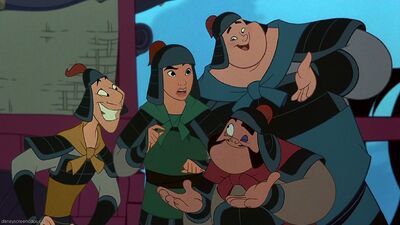
You may actually end up needing to draw characters in what seems like completely different styles that you may think would not work together at first. This is very common in American cartoons, and as this is a Disney Create wiki I thought that Disney would make a very good example for these kinds of characters. In Mulan, all of the characters are Chinese or, in the case of the Huns, Mongolian. As you can see in the picture I have used to the right, each character may have a different color of uniform, but that would not be enough to identify them as distinctly different characters. Instead, every character has very different builds and facial proportions. Just like manga eyes, the muscular build and overall proportions of the face can tell you a lot about a particular character, and Disney likes to exploit this to the best of their ability, especially in sidekick type characters. Just by their appearance, you can tell that Ling is very confident, Chien Po is kind, and Yao is tough. And Mulan is, well, the protagonist. Disney protagonists are often set apart from the other characters through their looks by being more realistic or attractive in appearance than the other people who interact with them, but look different enough from the generic background characters (who are often still good looking) that they still stand out in a crowd. Of course, with the new CGI technology, the extreme cartoonizing of the other characters isn't as easy to do as before, but I doubt that many of us will be using 3D modeling in the near future, so I'm just sticking to their classic style of animation.
Now, with these sorts of exaggerated styles you will need to know what you want to enlarge, shrink, lengthen, shorten, and so on with each character. If you want to enlarge some things, you will need to balance it out by shrinking others. Ling's character has a very big nose and mouth, but a small body. On the other hand, Chien Po has a large body and smaller facial features. These propotions give each character a very distinct appearance when compared to the other.
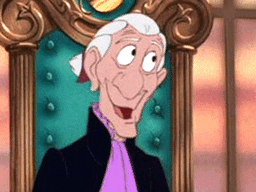
Disney also makes use of not only changing the proportions, but the facial features themselves. The character Grimsby from The Little Mermaid has very similar facial proportions to Ling, but since the shape of his jaw, nose, and eyebrows are different, he gives off a much more sophisticated vibe than does Ling. Since he is older, he can also be seen as wiser and more experienced, which is seen throughout the movie. Using these sorts of stereotypes is good if you're making a character who you will not want to go into too much detail on, since the viewers or readers will have already made the assumption that this character is well mannered before you explained it to them.
This article is currently unfinished![]
I still have a lot I am hoping to add, but as for now I am posting the article how it is right now. If you see any grammatical errors, please correct them! Once I finish this I will ask for more input to what I have already written as well. So, no editing until later unless you find that something is misspelled or is worded incorrectly.
Thank you!